SpringMVC、SpringFox和Swagger整合项目实例
目标
在做项目的时候,有时候需要提供其它平台(如业务平台)相关的HTTP接口,业务平台则通过开放的HTTP接口获取相关的内容,并完成自身业务~
提供对外开放HTTP API接口,比较常用的是采用Spring MVC来完成。
本文的目标是先搭建一个简单的Spring MVC应用,然后为Spring MVC整合SpringFox-Swagger以及SpringFox-Swagger-UI,最终,达到Spring MVC对外开放接口API文档化。
如下图所示:

搭建SpringMVC工程
新建Maven工程
Eclipse中,File --> New --> Maven Project,

点击“Next”按钮, 然后选择 “maven-archetype-webapp”,
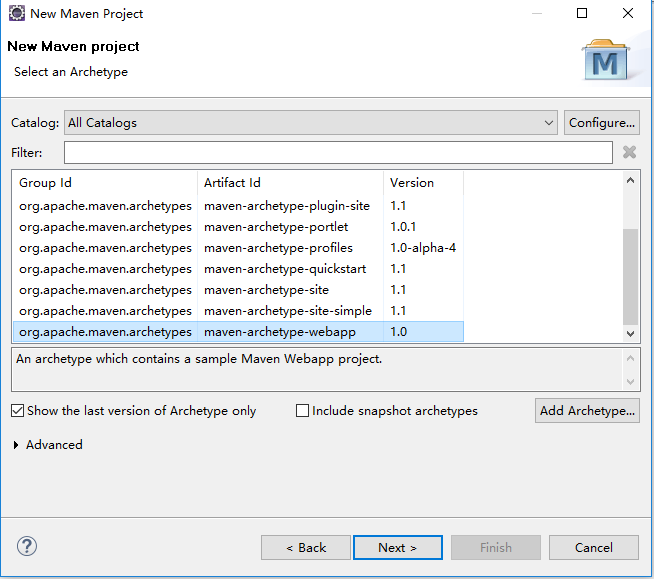
继续点击“Next”按钮,然后指定
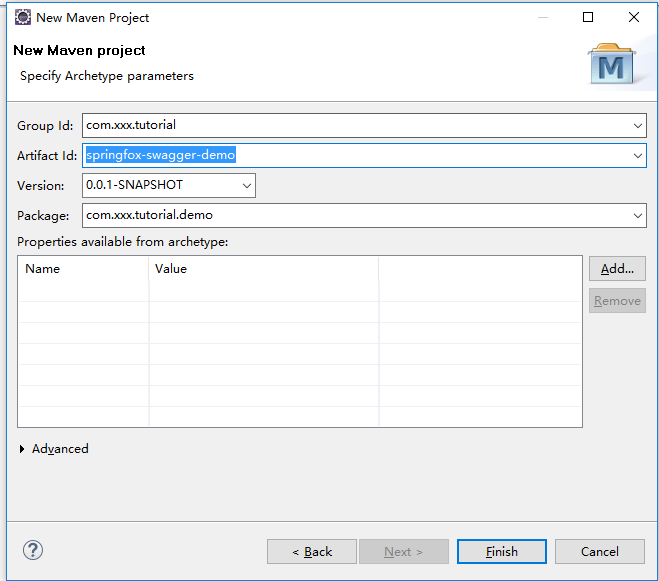
点击“Finish” 按钮结束~ 就这样,一个简单的Web工程就建好了~
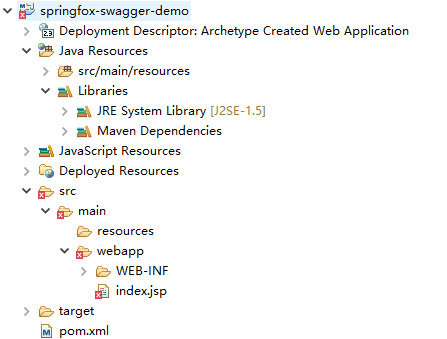
但是,
默认是使用J2SE-1.5, 配置一下Build Path,使用本地机器上安装的JDK
(本文中使用的是JDK 1.7),工程默认字体是GBK,将其改成UTF-8
完成后,Maven工程的结构如下图所示:

引入Spring依赖包
在本示例中,因为简单,所以只要引入如下几个jar包就好了~
<dependencies>
<!--引入Spring依赖包 -->
<dependency>
<groupId>org.springframework</groupId>
<artifactId>spring-core</artifactId>
<version>${spring.framework.version}</version>
</dependency>
<dependency>
<groupId>org.springframework</groupId>
<artifactId>spring-context</artifactId>
<version>${spring.framework.version}</version>
</dependency>
<dependency>
<groupId>org.springframework</groupId>
<artifactId>spring-webmvc</artifactId>
<version>${spring.framework.version}</version>
</dependency>
</dependencies>
完整的pom.xml文件内容如下:
<project xmlns="http://maven.apache.org/POM/4.0.0" xmlns:xsi="http://www.w3.org/2001/XMLSchema-instance"
xsi:schemaLocation="http://maven.apache.org/POM/4.0.0 http://maven.apache.org/maven-v4_0_0.xsd">
<modelVersion>4.0.0</modelVersion>
<groupId>com.xxx.tutorial</groupId>
<artifactId>springfox-swagger-demo</artifactId>
<packaging>war</packaging>
<version>0.0.1-SNAPSHOT</version>
<name>springfox-swagger-demo Maven Webapp</name>
<url>http://maven.apache.org</url> <properties>
<project.build.sourceEncoding>UTF-8</project.build.sourceEncoding>
<spring.framework.version>4.3.6.RELEASE</spring.framework.version>
</properties> <dependencies>
<!--引入Spring依赖包 -->
<dependency>
<groupId>org.springframework</groupId>
<artifactId>spring-core</artifactId>
<version>${spring.framework.version}</version>
</dependency>
<dependency>
<groupId>org.springframework</groupId>
<artifactId>spring-context</artifactId>
<version>${spring.framework.version}</version>
</dependency>
<dependency>
<groupId>org.springframework</groupId>
<artifactId>spring-webmvc</artifactId>
<version>${spring.framework.version}</version>
</dependency>
</dependencies> <build>
<finalName>springfox-swagger-demo</finalName>
</build>
</project>
编写spring-mvc.xml文件
<?xml version="1.0" encoding="UTF-8"?>
<beans xmlns="http://www.springframework.org/schema/beans"
xmlns:xsi="http://www.w3.org/2001/XMLSchema-instance" xmlns:context="http://www.springframework.org/schema/context"
xmlns:mvc="http://www.springframework.org/schema/mvc" xmlns:p="http://www.springframework.org/schema/p"
xsi:schemaLocation="http://www.springframework.org/schema/beans http://www.springframework.org/schema/beans/spring-beans-4.0.xsd
http://www.springframework.org/schema/context http://www.springframework.org/schema/context/spring-context-4.0.xsd
http://www.springframework.org/schema/mvc http://www.springframework.org/schema/mvc/spring-mvc-4.0.xsd"> <!-- 默认的注解映射的支持 ,它会自动注册DefaultAnnotationHandlerMapping 与AnnotationMethodHandlerAdapter -->
<mvc:annotation-driven /> <!-- 设置使用注解的类所在的jar包 -->
<context:component-scan base-package="com.htjf.controller" /> <!--这个是我的项目包结构--> </beans>
配置applicationContext.xml
<?xml version="1.0" encoding="UTF-8"?>
<beans xmlns="http://www.springframework.org/schema/beans"
xmlns:xsi="http://www.w3.org/2001/XMLSchema-instance"
xmlns:p="http://www.springframework.org/schema/p"
xmlns:context="http://www.springframework.org/schema/context"
xsi:schemaLocation="http://www.springframework.org/schema/beans
http://www.springframework.org/schema/beans/spring-beans-4.3.xsd
http://www.springframework.org/schema/context
http://www.springframework.org/schema/context/spring-context-4.3.xsd"> <!-- 启用注解扫描,并定义组件查找规则 ,除了@controller,扫描所有的Bean -->
<context:component-scan base-package="com.htjf"/> <!-- 启动SpringMVC的注解功能,完成请求和注解POJO的映射 -->
<bean class="org.springframework.web.servlet.mvc.annotation.AnnotationMethodHandlerAdapter" /> <!-- enable autowire 向容器自动注册 -->
<context:annotation-config />
</beans>
配置web.xml
<?xml version="1.0" encoding="UTF-8"?>
<web-app xmlns="http://xmlns.jcp.org/xml/ns/javaee"
xmlns:xsi="http://www.w3.org/2001/XMLSchema-instance"
xsi:schemaLocation="http://xmlns.jcp.org/xml/ns/javaee http://xmlns.jcp.org/xml/ns/javaee/web-app_3_1.xsd"
version="3.1">
<display-name>Archetype Created Web Application</display-name> <!-- 利用Spring提供的ContextLoaderListener监听器去监听ServletContext对象的创建,并初始化WebApplicationContext对象 -->
<listener>
<listener-class>org.springframework.web.context.ContextLoaderListener</listener-class>
</listener>
<!-- Context Configuration locations for Spring XML files(默认查找/WEB-INF/applicationContext.xml) -->
<context-param>
<param-name>contextConfigLocation</param-name>
<param-value>classpath:applicationContext.xml</param-value>
</context-param> <!-- 配置Spring MVC的前端控制器:DispatchcerServlet -->
<servlet>
<servlet-name>springmvc</servlet-name>
<servlet-class>org.springframework.web.servlet.DispatcherServlet</servlet-class>
<init-param>
<param-name>contextConfigLocation</param-name>
<param-value>classpath:spring-mvc.xml</param-value>
</init-param> <load-on-startup>1</load-on-startup>
<async-supported>true</async-supported>
</servlet> <servlet-mapping>
<servlet-name>springmvc</servlet-name>
<url-pattern>/</url-pattern>
</servlet-mapping> <!--字符编码过滤器-->
<filter>
<filter-name>encoding</filter-name>
<filter-class>org.springframework.web.filter.CharacterEncodingFilter</filter-class>
<init-param>
<param-name>encoding</param-name>
<param-value>UTF-8</param-value>
</init-param>
<init-param>
<param-name>forceEncoding</param-name>
<param-value>true</param-value>
</init-param>
</filter> <filter-mapping>
<filter-name>encoding</filter-name>
<url-pattern>/*</url-pattern>
</filter-mapping> </web-app>
编写Controller并测试
配置好spring-mvc.xml、applicationContext.xml以及web.xml文件之后,咱们继续往下走~
因为,本文Spring MVC示例的作用主要用来暴露对外HTTP API接口,先写一个简单的ProductController,其包含一个按照id查询的方法。
Product.java和ProductController.java的内容如下:
Product.java
package com.xxx.tutorial.model; import java.io.Serializable; /**
*
* @author wangmengjun
*
*/
public class Product implements Serializable { private static final long serialVersionUID = 1L; /**ID*/
private Long id; /**产品名称*/
private String name; /**产品型号*/
private String productClass; /**产品ID*/
private String productId; /**
* @return the id
*/
public Long getId() {
return id;
} /**
* @param id
* the id to set
*/
public void setId(Long id) {
this.id = id;
} /**
* @return the name
*/
public String getName() {
return name;
} /**
* @param name
* the name to set
*/
public void setName(String name) {
this.name = name;
} /**
* @return the productClass
*/
public String getProductClass() {
return productClass;
} /**
* @param productClass
* the productClass to set
*/
public void setProductClass(String productClass) {
this.productClass = productClass;
} /**
* @return the productId
*/
public String getProductId() {
return productId;
} /**
* @param productId
* the productId to set
*/
public void setProductId(String productId) {
this.productId = productId;
} /*
* (non-Javadoc)
*
* @see java.lang.Object#toString()
*/
@Override
public String toString() {
return "Product [id=" + id + ", name=" + name + ", productClass=" + productClass + ", productId=" + productId
+ "]";
} }
ProductController.java
package com.xxx.tutorial.controller; import org.springframework.http.ResponseEntity;
import org.springframework.web.bind.annotation.PathVariable;
import org.springframework.web.bind.annotation.RequestMapping;
import org.springframework.web.bind.annotation.RequestMethod;
import org.springframework.web.bind.annotation.RestController; import com.xxx.tutorial.model.Product; @RestController
@RequestMapping(value = { "/api/product/"})
public class ProductController { @RequestMapping(value = "/{id}", method = RequestMethod.GET)
public ResponseEntity<Product> get(@PathVariable Long id) {
Product product = new Product();
product.setName("七级滤芯净水器");
product.setId(1L);
product.setProductClass("seven_filters");
product.setProductId("T12345");
return ResponseEntity.ok(product);
}
}
注:
鉴于是一个demo示例,所以没有写ProductService以及相关DAO, 直接在方法中返回固定的Product信息~
验证Spring MVC是否ok
完成Controller的代码,运行Spring MVC项目,然后,看一下Spring MVC是否运行ok,访问URL地址
http://localhost:8888/springfox-swagger-demo/api/product/1
- 出现错误

详细的错误信息如下:
五月 23, 2017 3:00:55 下午 org.apache.catalina.core.StandardWrapperValve invoke
严重: Servlet.service() for servlet [spring-mvc] in context with path [/springfox-swagger-demo] threw exception [Request processing failed; nested exception is java.lang.IllegalArgumentException: No converter found for return value of type: class com.xxx.tutorial.model.Product] with root cause
java.lang.IllegalArgumentException: No converter found for return value of type: class com.xxx.tutorial.model.Product
at org.springframework.web.servlet.mvc.method.annotation.AbstractMessageConverterMethodProcessor.writeWithMessageConverters(AbstractMessageConverterMethodProcessor.java:187)
at org.springframework.web.servlet.mvc.method.annotation.HttpEntityMethodProcessor.handleReturnValue(HttpEntityMethodProcessor.java:203)
at org.springframework.web.method.support.HandlerMethodReturnValueHandlerComposite.handleReturnValue(HandlerMethodReturnValueHandlerComposite.java:81)
at org.springframework.web.servlet.mvc.method.annotation.ServletInvocableHandlerMethod.invokeAndHandle(ServletInvocableHandlerMethod.java:132)
at org.springframework.web.servlet.mvc.method.annotation.RequestMappingHandlerAdapter.invokeHandlerMethod(RequestMappingHandlerAdapter.java:827)
at org.springframework.web.servlet.mvc.method.annotation.RequestMappingHandlerAdapter.handleInternal(RequestMappingHandlerAdapter.java:738)
at org.springframework.web.servlet.mvc.method.AbstractHandlerMethodAdapter.handle(AbstractHandlerMethodAdapter.java:85)
at org.springframework.web.servlet.DispatcherServlet.doDispatch(DispatcherServlet.java:963)
at org.springframework.web.servlet.DispatcherServlet.doService(DispatcherServlet.java:897)
at org.springframework.web.servlet.FrameworkServlet.processRequest(FrameworkServlet.java:970)
at org.springframework.web.servlet.FrameworkServlet.doGet(FrameworkServlet.java:861)
at javax.servlet.http.HttpServlet.service(HttpServlet.java:624)
at org.springframework.web.servlet.FrameworkServlet.service(FrameworkServlet.java:846)
at javax.servlet.http.HttpServlet.service(HttpServlet.java:731)
at org.apache.catalina.core.ApplicationFilterChain.internalDoFilter(ApplicationFilterChain.java:303)
at org.apache.catalina.core.ApplicationFilterChain.doFilter(ApplicationFilterChain.java:208)
at org.apache.tomcat.websocket.server.WsFilter.doFilter(WsFilter.java:52)
at org.apache.catalina.core.ApplicationFilterChain.internalDoFilter(ApplicationFilterChain.java:241)
at org.apache.catalina.core.ApplicationFilterChain.doFilter(ApplicationFilterChain.java:208)
at org.springframework.web.filter.CharacterEncodingFilter.doFilterInternal(CharacterEncodingFilter.java:197)
at org.springframework.web.filter.OncePerRequestFilter.doFilter(OncePerRequestFilter.java:107)
at org.apache.catalina.core.ApplicationFilterChain.internalDoFilter(ApplicationFilterChain.java:241)
at org.apache.catalina.core.ApplicationFilterChain.doFilter(ApplicationFilterChain.java:208)
at org.apache.catalina.core.StandardWrapperValve.invoke(StandardWrapperValve.java:220)
at org.apache.catalina.core.StandardContextValve.invoke(StandardContextValve.java:122)
at org.apache.catalina.core.StandardHostValve.invoke(StandardHostValve.java:170)
at org.apache.catalina.valves.ErrorReportValve.invoke(ErrorReportValve.java:103)
at org.apache.catalina.valves.AccessLogValve.invoke(AccessLogValve.java:957)
at org.apache.catalina.core.StandardEngineValve.invoke(StandardEngineValve.java:116)
at org.apache.catalina.connector.CoyoteAdapter.service(CoyoteAdapter.java:423)
at org.apache.coyote.http11.AbstractHttp11Processor.process(AbstractHttp11Processor.java:1079)
at org.apache.coyote.AbstractProtocol$AbstractConnectionHandler.process(AbstractProtocol.java:620)
at org.apache.tomcat.util.net.JIoEndpoint$SocketProcessor.run(JIoEndpoint.java:316)
at java.util.concurrent.ThreadPoolExecutor.runWorker(Unknown Source)
at java.util.concurrent.ThreadPoolExecutor$Worker.run(Unknown Source)
at org.apache.tomcat.util.threads.TaskThread$WrappingRunnable.run(TaskThread.java:61)
at java.lang.Thread.run(Unknown Source)
解决方法,添加jackson-databind依赖包即可~
<dependency>
<groupId>com.fasterxml.jackson.core</groupId>
<artifactId>jackson-databind</artifactId>
<version>2.6.6</version>
</dependency>
重新启动,运行一下,成功返回信息~

为了看的更加清楚,可以使用postman来完成~, 如~

至此,一个简单的基于SpringMVC的Web项目已经创建,并能对外提供API接口~

接下来,我们要整合SpringFox和SwaggerUI到该SpringMVC项目中去,使其对外接口文档化
整合SpringFox-Swagger
SpringFox【SpringFox链接】已经可以代替Swagger-SpringMVC, 目前SpringFox同时支持Swagger 1.2 和 2.0.
在SpringMVC项目中整合SpringFox-Swagger只要如下几步即可~
- 添加SpringFox-Swagger依赖
- 添加SwaggerConfig
添加依赖
<dependency>
<groupId>io.springfox</groupId>
<artifactId>springfox-swagger2</artifactId>
<version>2.7.0</version>
</dependency>
添加SwaggerConfig
package com.htjf.config; import org.springframework.context.annotation.Bean;
import org.springframework.context.annotation.ComponentScan;
import org.springframework.context.annotation.Configuration;
import org.springframework.web.servlet.config.annotation.EnableWebMvc; import springfox.documentation.builders.ApiInfoBuilder;
import springfox.documentation.builders.RequestHandlerSelectors;
import springfox.documentation.service.ApiInfo;
import springfox.documentation.spi.DocumentationType;
import springfox.documentation.spring.web.plugins.Docket;
import springfox.documentation.swagger2.annotations.EnableSwagger2; @Configuration
@EnableSwagger2
@ComponentScan(basePackages= {"com.htjf.controller"})
@EnableWebMvc
public class SwaggerConfig { @Bean
public Docket api() {
return new Docket(DocumentationType.SWAGGER_2)
.select()
.apis(RequestHandlerSelectors.any())
.build()
.apiInfo(apiInfo());
} private ApiInfo apiInfo() {
return new ApiInfoBuilder()
.title("对外开放接口API 文档") //大标题 title
.description("HTTP对外开放接口") //小标题
.version("1.0.0") //版本
.termsOfServiceUrl("http://xxx.xxx.com") //终端服务程序
.license("LICENSE") //链接显示文字
.licenseUrl("http://xxx.xxx.com") //网站链接
.build();
}
}
整合SpringFox-Swagger-UI
在SpringMVC项目中整合SpringFox-Swagger-UI也只要如下两个步骤即可~
- 添加SpringFox-Swagger-UI依赖
- 添加配置
添加依赖
<dependency>
<groupId>io.springfox</groupId>
<artifactId>springfox-swagger-ui</artifactId>
<version>2.7.0</version>
</dependency>
添加配置
在添加配置之前,一起来看一下swagger-ui中使用的静态资源文件(如 swagger-ui.html )放在那里~
spingfox-swagger-ui-2.7.0.jar中的/META-INF/resources/下~ 如下图所示:
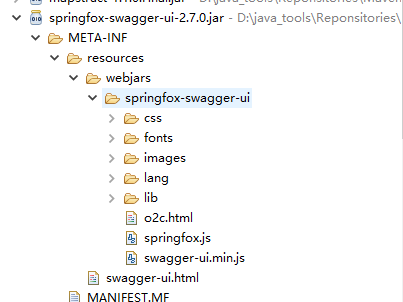
为了访问swagger-ui.html,我们配置对这些静态资源的访问~ 如:
package com.xxx.tutorial.config; import org.springframework.context.annotation.Configuration;
import org.springframework.web.servlet.config.annotation.EnableWebMvc;
import org.springframework.web.servlet.config.annotation.ResourceHandlerRegistry;
import org.springframework.web.servlet.config.annotation.WebMvcConfigurerAdapter; @Configuration
@EnableWebMvc
public class WebAppConfig extends WebMvcConfigurerAdapter { @Override
public void addResourceHandlers(ResourceHandlerRegistry registry) {
registry.addResourceHandler("swagger-ui.html").addResourceLocations("classpath:/META-INF/resources/");
registry.addResourceHandler("/webjars/**").addResourceLocations("classpath:/META-INF/resources/webjars/");
} }
该配置代码的效果和如下代码等价~
<mvc:resources mapping="swagger-ui.html" location="classpath:/META-INF/resources/" />
<mvc:resources mapping="/webjars/**"
location="classpath:/META-INF/resources/webjars/" />
在本文中,可以将其配置在spring-mvc.xml中,
<?xml version="1.0" encoding="UTF-8"?>
<beans xmlns="http://www.springframework.org/schema/beans"
xmlns:xsi="http://www.w3.org/2001/XMLSchema-instance" xmlns:context="http://www.springframework.org/schema/context"
xmlns:mvc="http://www.springframework.org/schema/mvc" xmlns:p="http://www.springframework.org/schema/p"
xsi:schemaLocation="http://www.springframework.org/schema/beans http://www.springframework.org/schema/beans/spring-beans-4.0.xsd
http://www.springframework.org/schema/context http://www.springframework.org/schema/context/spring-context-4.0.xsd
http://www.springframework.org/schema/mvc http://www.springframework.org/schema/mvc/spring-mvc-4.0.xsd"> <!-- 默认的注解映射的支持 ,它会自动注册DefaultAnnotationHandlerMapping 与AnnotationMethodHandlerAdapter -->
<mvc:annotation-driven /> <!-- 设置使用注解的类所在的jar包 -->
<context:component-scan base-package="com.htjf.controller" /> <mvc:resources location="classpath:/META-INF/resources/" mapping="swagger-ui.html"/>
<mvc:resources location="classpath:/META-INF/resources/webjars/" mapping="/webjars/**"/>
</beans>
API接口说明代码添加并测试
经过上述几个步骤之后,之前写的ProductController的接口,就可以实现文档化了,如本文通过如下的访问地址访问:
http://localhost:8888/springfox-swagger-demo/swagger-ui.html

这个接口API雏形出来了,但是还缺少点东西,比如:接口方法的描述等都没有~
修改一下,ProductController.java内容,如:
package com.xxx.tutorial.controller; import org.springframework.http.ResponseEntity;
import org.springframework.web.bind.annotation.PathVariable;
import org.springframework.web.bind.annotation.RequestMapping;
import org.springframework.web.bind.annotation.RequestMethod;
import org.springframework.web.bind.annotation.RestController; import com.xxx.tutorial.model.Product; import io.swagger.annotations.Api;
import io.swagger.annotations.ApiOperation; @RestController
@RequestMapping(value = { "/api/product/" })
@Api(value = "/product", tags = "Product接口")
public class ProductController { @RequestMapping(value = "/{id}", method = RequestMethod.GET)
@ApiOperation(value = "根据id获取产品信息", notes = "根据id获取产品信息", httpMethod = "GET", response = Product.class)
public ResponseEntity<Product> get(@PathVariable Long id) {
Product product = new Product();
product.setName("七级滤芯净水器");
product.setId(1L);
product.setProductClass("seven_filters");
product.setProductId("T12345");
return ResponseEntity.ok(product);
}
}
重新访问,接口已经出现多个我们指定的描述信息~

在参数id栏中输入1,然后点击“try it out”按钮~ 可以查看接口调用结果~
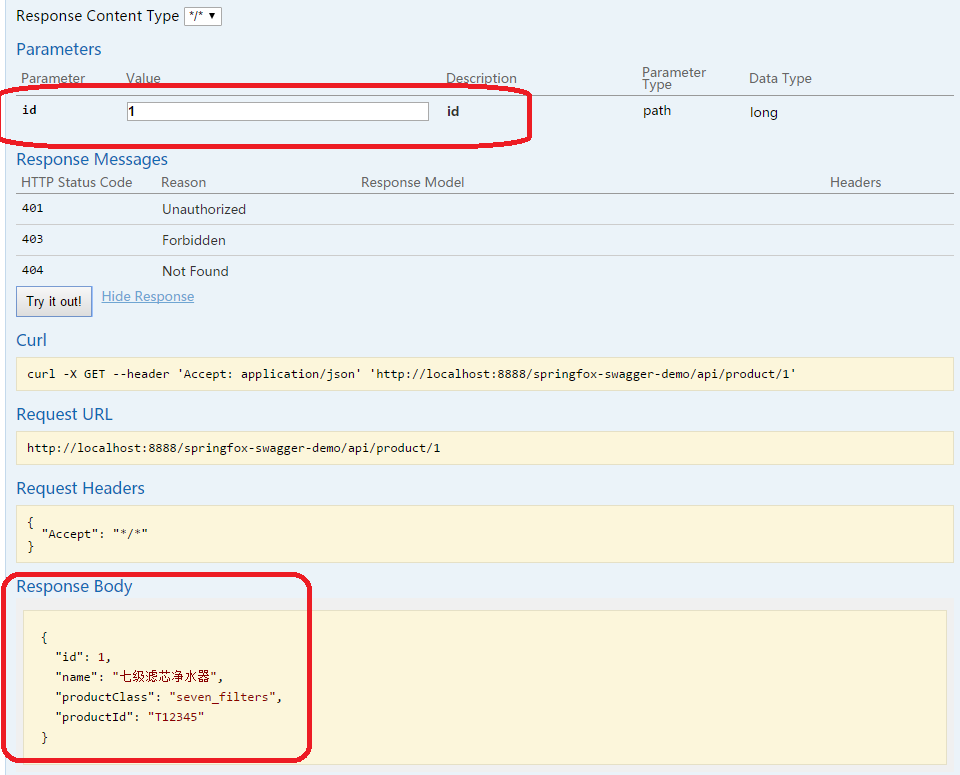
至此一个简单的示例就完成了~
稍微增加几个接口
修改ProductController
package com.xxx.tutorial.controller;
import java.util.Arrays;
import java.util.List;
import org.springframework.http.ResponseEntity;
import org.springframework.web.bind.annotation.PathVariable;
import org.springframework.web.bind.annotation.RequestMapping;
import org.springframework.web.bind.annotation.RequestMethod;
import org.springframework.web.bind.annotation.RestController;
import com.xxx.tutorial.model.Product;
import io.swagger.annotations.Api;
import io.swagger.annotations.ApiOperation;
import io.swagger.annotations.ApiResponse;
import io.swagger.annotations.ApiResponses;
@RestController
@RequestMapping(value = { "/api/product/" })
@Api(value = "/product", tags = "Product接口")
public class ProductController {
@RequestMapping(value = "/{id}", method = RequestMethod.GET)
@ApiResponses(value= {
@ApiResponse(code = 400,message="参数错误"),
@ApiResponse(code = 401,message="要求用户的身份认证"),
@ApiResponse(code = 403,message="拒绝执行此请求"),
@ApiResponse(code = 404,message="系统资源未发现"),
@ApiResponse(code = 500,message="系统错误"),
@ApiResponse(code = 200,message="成功,其它为错误,返回格式:{code:0,data[{}]},data中的属性参照下方Model",response=Product.class)})
@ApiOperation(value = "根据id获取产品信息", notes = "根据id获取产品信息", httpMethod = "GET")
public ResponseEntity<Product> get(@PathVariable Long id) {
Product product = new Product();
product.setName("七级滤芯净水器");
product.setId(1L);
product.setProductClass("seven_filters");
product.setProductId("T12345");
return ResponseEntity.ok(product);
}
@RequestMapping(method = RequestMethod.POST)
@ApiOperation(value = "添加一个新的产品")
@ApiResponses(value = {
@ApiResponse(code = 201,message="已创建。成功请求并创建了新的资源"),
@ApiResponse(code = 401,message="要求用户的身份认证"),
@ApiResponse(code = 403,message="拒绝执行此请求"),
@ApiResponse(code = 404,message="系统资源未发现"),
@ApiResponse(code = 405, message = "参数错误"),
@ApiResponse(code = 200,message="成功,其它为错误,返回格式:{code:0,data[{}]},data中的属性参照下方Model",response=String.class)})
public ResponseEntity<String> add(Product product) {
return ResponseEntity.ok("SUCCESS");
}
@RequestMapping(method = RequestMethod.PUT)
@ApiOperation(value = "更新一个产品")
@ApiResponses(value = {
@ApiResponse(code = 200,message="成功,其它为错误,返回格式:{code:0,data[{}]},data中的属性参照下方Model",response=String.class),
@ApiResponse(code = 201,message="已创建。成功请求并创建了新的资源"),
@ApiResponse(code = 400, message = "参数错误"),
@ApiResponse(code = 401,message="要求用户的身份认证"),
@ApiResponse(code = 403,message="拒绝执行此请求"),
@ApiResponse(code = 404,message="系统资源未发现")})
public ResponseEntity<String> update(Product product) {
return ResponseEntity.ok("SUCCESS");
}
@RequestMapping(method = RequestMethod.GET)
@ApiOperation(value = "获取所有产品信息", notes = "获取所有产品信息", httpMethod = "GET", response = Product.class, responseContainer = "List")
public ResponseEntity<List<Product>> getAllProducts() {
Product product = new Product();
product.setName("七级滤芯净水器");
product.setId(1L);
product.setProductClass("seven_filters");
product.setProductId("T12345");
return ResponseEntity.ok(Arrays.asList(product, product));
}
}
@RequestMapping(method=RequestMethod.DELETE)
@ApiOperation(value="删除某个产品信息",notes="删除某个产品信息")
/* @ApiImplicitParams(@ApiImplicitParam(name="carOwnerName",value="产品id",dataType="Long"))*/
@ApiResponses(value= {
@ApiResponse(code = 204,message="无内容。服务器成功处理,但未返回内容!"),
@ApiResponse(code = 400,message="参数错误"),
@ApiResponse(code = 401,message="要求用户的身份认证"),
@ApiResponse(code = 403,message="拒绝执行此请求"),
@ApiResponse(code = 500,message="系统错误"),
@ApiResponse(code = 200,message="成功,其它为错误,返回格式:{code:0,data[{}]},data中的属性参照下方Model",response=String.class)})
public ResponseEntity<String> delete(@PathVariable Long id){
if(carOwnerName==null) {
return new ResponseEntity<String>(HttpStatus.NO_CONTENT);
}else {
return ResponseEntity.ok("SUCCESS");
}
}
swagger-ui展示

由上图可以看出,不同的method(GET / PUT / POST等)都会以不同的颜色展示出来~
Swagger-ui的添加,可以帮助他人查看接口信息,并在页面上进行输入参数来调用接口~
Maven工程的目录如下:
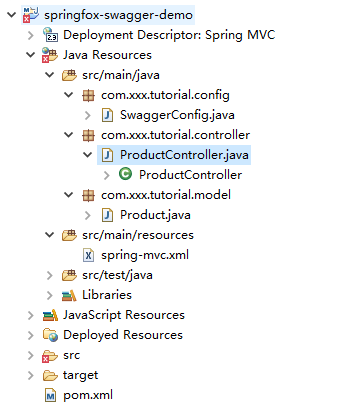
本文只是一个简单的整合示例,大家只要操作一下就能出来结果。
接下来讲解Swagger 常用注解使用
--@Api()用于类;
表示这个类是一个swagger的资源。它有两个属性,分别是:
String value();---也是说明,可以使用tags替代
String[] tags();---是一个数组,表示说明,tags如果有多个值,会生成多个list;
例如:
@Api(value="用户controller",tags={"用户操作接口"})
@RestController
public class UserController {
}
ui效果图:
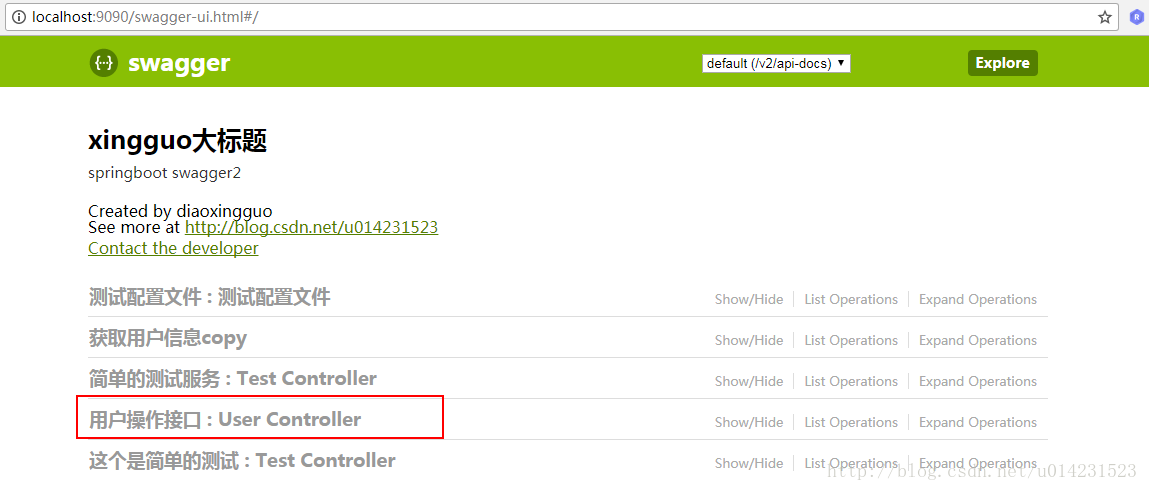
--@ApiOperation()用于方法;
表示一个http请求的操作 ,它有4个常用属性:
String value();--用于方法描述;
String notes();--用于提示内容
String[] tags();--可以重新分组(视情况而用)
String httpMethod(); --请求方法类型,例如:httpMethod=“GET”;
--@ApiParam() 用于方法,参数,字段说明;表示对参数的添加元数据(说明或是否必填等) ,它有几个常用参数:
String name();--参数名
String value();--参数说明
boolean required();--是否必填
boolean allowEmptyValue();--是否允许有空值
例如:
@Api(value="用户controller",tags={"用户操作接口"})
@RestController
public class UserController {
@ApiOperation(value="获取用户信息",tags={"获取用户信息copy"},notes="注意问题点")
@GetMapping("/getUserInfo")
public User getUserInfo(@ApiParam(name="id",value="用户id",required=true) Long id,@ApiParam(name="username",value="用户名") String username) {
// userService可忽略,是业务逻辑
User user = userService.getUserInfo();
return user;
}
}
ui效果图:
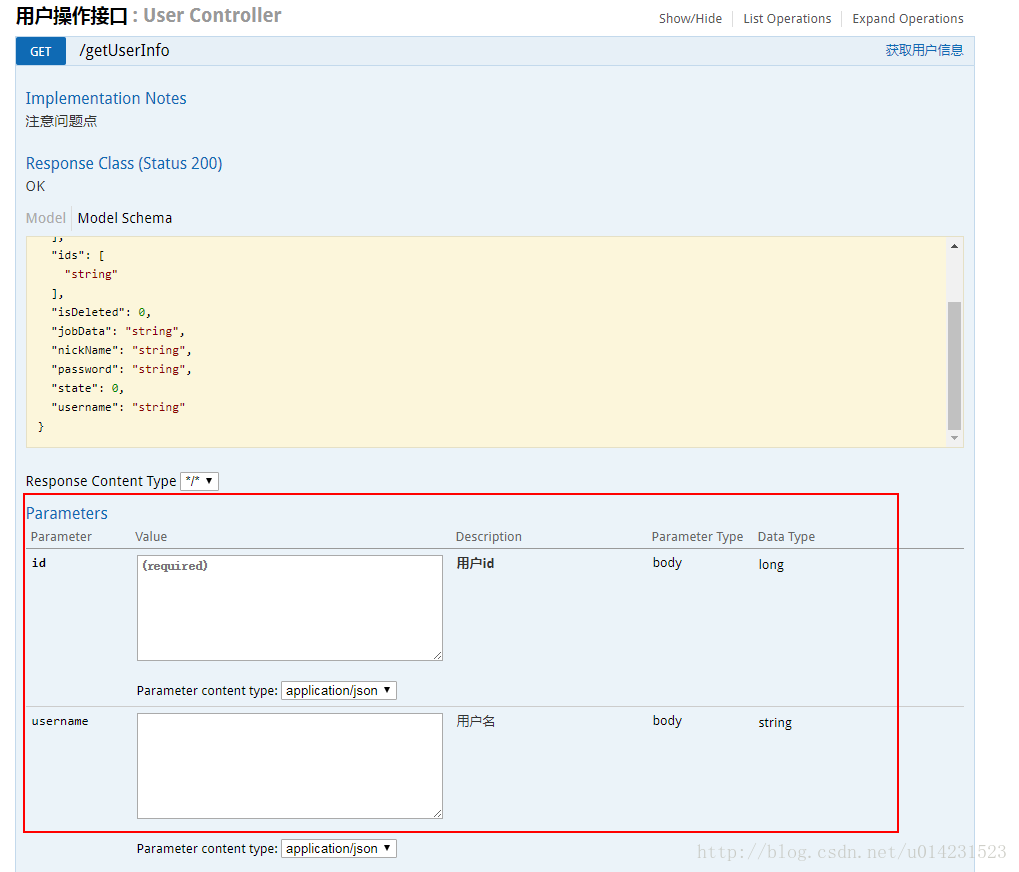
--@ApiModel()用于类 ;表示对类进行说明,用于参数用实体类接收
value–表示对象名
description–描述
都可省略
--@ApiModelProperty()用于方法,字段; 表示对model属性的说明或者数据操作更改
value–字段说明
name–重写属性名字
dataType–重写属性类型
required–是否必填
example–举例说明
hidden–隐藏
例如:
@ApiModel(value="user对象",description="用户对象user")
public class User implements Serializable{
private static final long serialVersionUID = 1L;
@ApiModelProperty(value="用户名",name="username",example="xingguo")
private String username;
@ApiModelProperty(value="状态",name="state",required=true)
private Integer state;
private String password;
private String nickName;
private Integer isDeleted; @ApiModelProperty(value="id数组",hidden=true)
private String[] ids;
private List<String> idList;
//省略get/set
}
@ApiOperation("更改用户信息")
@PostMapping("/updateUserInfo")
public int updateUserInfo(@RequestBody @ApiParam(name="用户对象",value="传入json格式",required=true) User user){
//注意,一定要添加@RequestBody注解
int num = userService.updateUserInfo(user);
return num;
}
ui效果图:
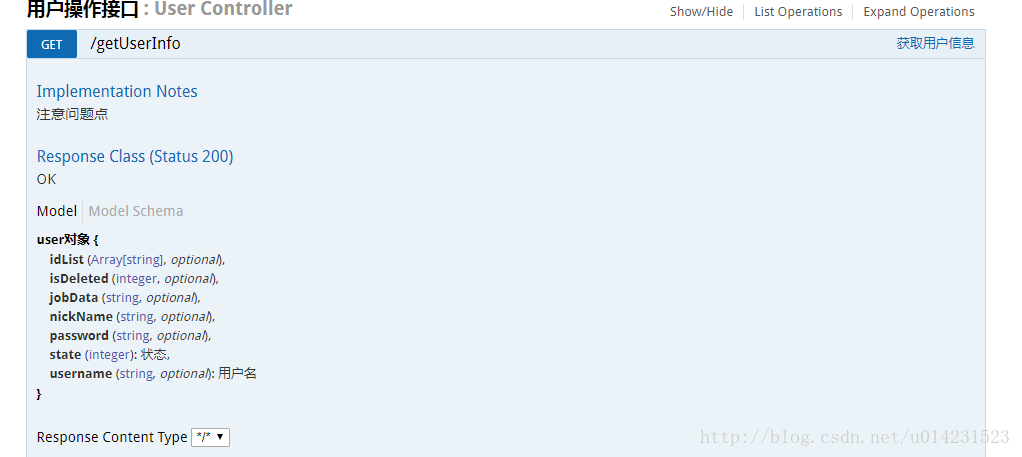
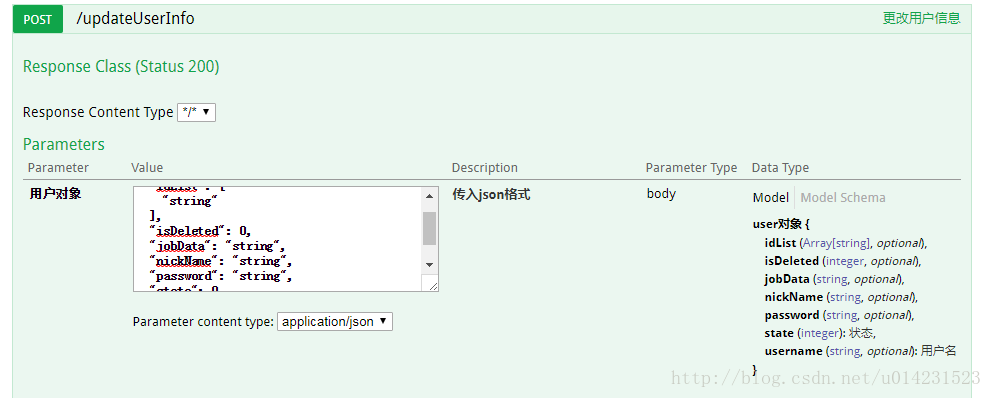
--@ApiIgnore()用于类或者方法上,可以不被swagger显示在页面上
比较简单, 这里不做举例
--@ApiImplicitParam() 用于方法
表示单独的请求参数
@ApiImplicitParams() 用于方法,包含多个 @ApiImplicitParam
name–参数ming
value–参数说明
dataType–数据类型
paramType–参数类型
example–举例说明
*****在controller层使用@RequestParam的时候,发现这个参数是必须要输入值的,但是我们有时候必须查询的时候允许参数为空,使用这个注解就不行了。但是使用@ApiImplicitParam这个注解可以解决这个问题。
例如:
@ApiOperation("查询测试")
@GetMapping("select")
//@ApiImplicitParam(name="name",value="用户名",dataType="String", paramType = "query")
@ApiImplicitParams({
@ApiImplicitParam(name="name",value="用户名",dataType="string", paramType = "query",example="xingguo"),
@ApiImplicitParam(name="id",value="用户id",dataType="long", paramType = "query")})
public void select(){
}
ui效果图:
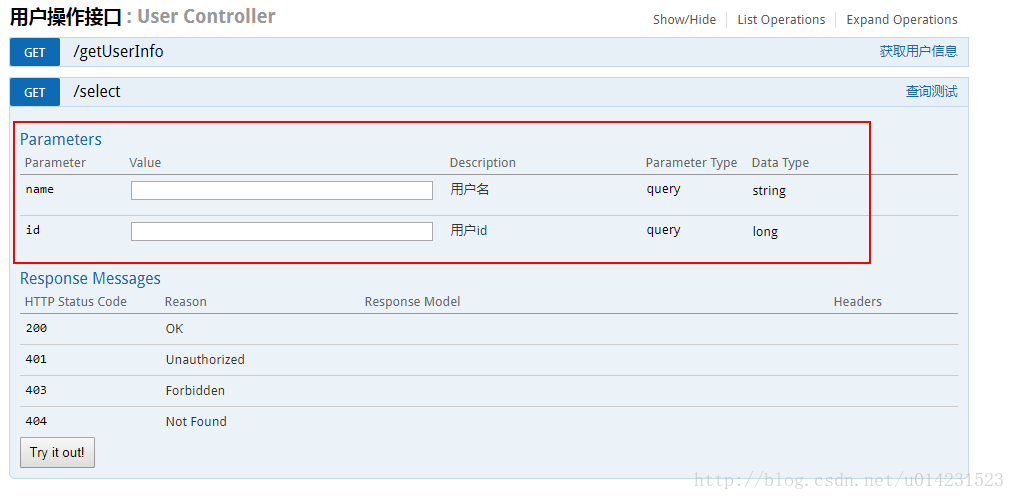
更加详细的文档,有兴趣的小伙伴可以访问swagger-ui的官网查看~
SpringMVC、SpringFox和Swagger整合项目实例的更多相关文章
- 一步步完成Maven+SpringMVC+SpringFox+Swagger整合示例
本文给出一个整合Maven+SpringMVC+SpringFOX+Swagger的示例,并且一步步给出完成步骤. 本人在做实例时发现 http://blog.csdn.net/zth1002/art ...
- Springfox与swagger的整合使用
一.前言 让我们先理一下springfox与swagger的关系. swagger是一个流行的API开发框架,这个框架以“开放API声明”(OpenAPI Specification,OAS)为基础, ...
- Springfox与swagger的整合使用(十七)
一.前言 让我们先理一下springfox与swagger的关系. swagger是一个流行的API开发框架,这个框架以“开放API声明”(OpenAPI Specification,OAS)为基础, ...
- SpringMVC中使用Swagger2整合
Swagger2是什么 Swagger 是一款RESTFUL接口的文档在线自动生成+功能测试功能软件. Swagger 是一个规范和完整的框架,用于生成.描述.调用和可视化 RESTful 风格的 W ...
- spring mvc和swagger整合
pom.xml 导入jar jar包 所属 备注 spring-core spring spring核心包 spring-expression spring spEl表达式 spring-beans ...
- SpringBoot+Swagger整合API
SpringBoot+Swagger整合API Swagger:整合规范的api,有界面的操作,测试 1.在pom.xml加入swagger依赖 <!--整合Swagger2配置类--> ...
- springboot+jpa+mysql+swagger整合
Springboot+jpa+MySQL+swagger整合 创建一个springboot web项目 <dependencies> <dependency> < ...
- Zuul Swagger 整合
疯狂创客圈 Java 高并发[ 亿级流量聊天室实战]实战系列 [博客园总入口 ] 架构师成长+面试必备之 高并发基础书籍 [Netty Zookeeper Redis 高并发实战 ] 前言 Crazy ...
- Swagger整合Jwt授权配置
Swagger整合Jwt授权配置 欢迎关注博主公众号「Java大师」, 专注于分享Java领域干货文章http://www.javaman.cn/sb2/swagger-jwt 一.Swagger入门 ...
随机推荐
- mysql索引原理及优化(二)
索引原理分析:数据结构 索引是最常见的慢查询优化方式其是一种优化查询的数据结构,MySql中的索引是用B+树实现,而B+树就是一种数据结构,可以优化查询速度,可以利用索引快速查找数据,优化查询. 可以 ...
- pip常用命令(转载)
用阿里云服务器,使用pip安装第三方库的时候卡的要死.所以我就想pip能不能安装本地的包. 找到了这篇博客: http://me.iblogc.com/2015/01/01/pip%E5%B8%B8% ...
- CentOS 7 安装FTP服务器(vsftpd)
FTP是安装各种环境前的预备环节,因为我们要把下载好的安装包上传上去.其次,在一个团队中,FTP服务器为多用户提供了一个文件储存场所,总之是一个非常实用的工具. 1.安装vsftpd # 首先要查看你 ...
- 开发人员不得不知的MySQL索引和查询优化
转载:https://blog.csdn.net/enmotech/article/details/88809822 本文主要总结了慢查询优化的过程中常用的以及不合理的操作,适合有 MySQL 基础的 ...
- babelrc笔记
Babel默认只是转换新的语法(简单转换语法糖),如箭头函数等,但不会转换新的API,如Iterator.Generator.Set.Maps.Proxy.Reflect.Symbol.Promise ...
- jenkins部署集群
环境: 两台Centos7.3系统 master:172.16.1.227 slave:172.16.1.228 其中一台作为master,另一台为slave(slave服务器上无需安装jenkins ...
- Jenkins - 参数化构建
1 - 设置 根据输入的参数来执行不同的构建过程. 参数TIME作为环境变量,可以被引用. 项目的首页会出现" Build with Parameters"功能链接,没有了&quo ...
- python常用的字符串格式化有哪几种?
常用字符串格式化%和format 皇城PK Python中格式化字符串目前有两种阵营:%和format,我们应该选择哪种呢? 自从Python2.6引入了format这个格式化字符串的方法之后,我认为 ...
- 七、spring生命周期之初始化和销毁方法
一.通过@Bean指定初始化和销毁方法 在以往的xml中,我们是这样配置的 <bean id="exampleInitBean" class="examples.E ...
- SecureCRT字体、界面优化
SecureCRT字体.界面优化 本文是secureCRT的第三篇博文,也是目前secureCRT优化的最终篇.首次使用该软件时候.应该会设置字体和编码,接下来,将演示如何设置. 1. 字体.编码设置 ...
